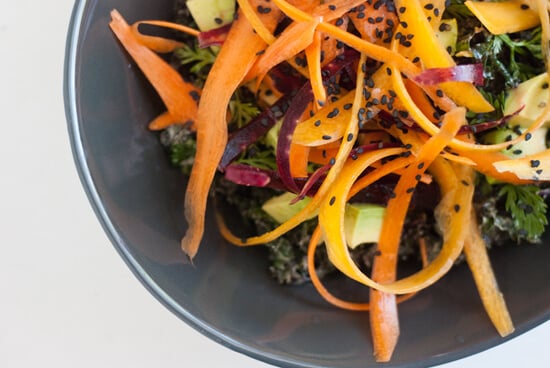In my practice I prescribe a Plant-Based Diet as part of the Living Well 4™, a four stage healing process that integrates the three therapies of Gemmotherapy, Homeopathy, and a Plant-Based Diet. The past four weeks my posts have highlighted each of the four stages in healing and the general protocols used. In the next few posts I’d like to support your shift to a Plant-Based Diet by sharing changes we made in my own home.

Eating more raw fruits and vegetables is a super important component of a Plant-Based Diet. The benefits from consuming more raw fruits and vegetables include:
- Alkalizing the body’s pH
- Activation of the lymphatic cleansing
- Improved digestion
- Decreased inflammation
All of this is important because a body that uses the lymphatic system to clean and eliminate optimally can heal itself. Your daily goal should be to eat a portion of raw salad before each cooked meal. So that means a lot of salads! To do that with enthusiasm it is important to have lots of options, a set of staples that are always on hand and a recipe-free plan to assemble some smash hits. Keep in mind good salad construction is all about simplicity and nourishing whole food ingredients.
Ready to get started? I’d like to share my go-to building blocks to assemble endless salad combinations that we never grow weary of. Here’s how I break salad making down in my kitchen:
Bases & Textures
- All varieties of Baby Leaf Greens: Spinach, Kale, Spring Lettuces, Arugula, etc
- Torn whole leaves: Butter, Romaine, Red Curly, Endive, Frisee, Romaine
- Chopped: Kales, Romaine
- Grated: Root Veggies, Kohlrabi, and firm fruits such as apples
- Julienne: Carrots, Beets, Kohlrabi, Celeriac, Jicama
Add-ins
- Seeds: raw or dry toasted Hemp, Flax, Sesame, Pumpkin, Sunflower
- Nuts: Walnut, Cashew, Hazelnut, Macadamia, Pistachio, Almonds, Filbert
- Dried Fruits: Raisins (Golden, Black and Sultanas), Dates, Figs, Cherries, Cranberries, Goji, Plums
- Fresh Fruits: thin slices of all varieties of Apple or Pear, Asian Pear, Peaches or Plums, Mango, Papaya

Dressings
Choose one of the following Consistencies—Vinaigrette, Nut Based or Creamy
Base: Olive Oil, Nut Oil, Tahini, Walnuts, Almonds (Almond Butter), Cashews (Cashew Butter), Vegan Mayo, Dijon Mustard, Avocados
Citrus or Acid: fresh squeezed Lemon,Lime, Orange or Grapefruit, Apple Cider Vinegar, Tamari Sauce, Mustard, Miso paste
Sweetener: Dates, Maple Syrup, Honey
Herbs and Spices: Green Onions, Garlic, Shallots, Cilantro, Basil, Parsley, Mint, Tarragon, Thyme, Pink Himalayan Salt, Fresh Ground Pepper
More on eating a Plant-Based Diet
So is eating a Plant-Based Diet the same as being Vegan? Actually no, eating Plant-Based means consuming a diet that includes 80% or more whole foods from plants. The remaining 20% can be animal protein and small amounts of processed foods. It is important to distinguish Plant-Based eating from a Vegan diet because the difference lies in the core purpose. The goal of Plant-Based eating is just that, to consume as many whole food, plant based, nutrient dense foods as possible. While the medical community that promotes a Plant-Based Diet does not promote consuming animal protein they make an allowance for it. For my clients I suggest that the main source of protein is consumed with the evening meal as it will take the most energy of all your foods to digest, making you sleepy at a logical time of the day. Want do the experts have to say about the benefits of Plant-Based Eating? Here are a few recent studies:

Thanks for the great hints.